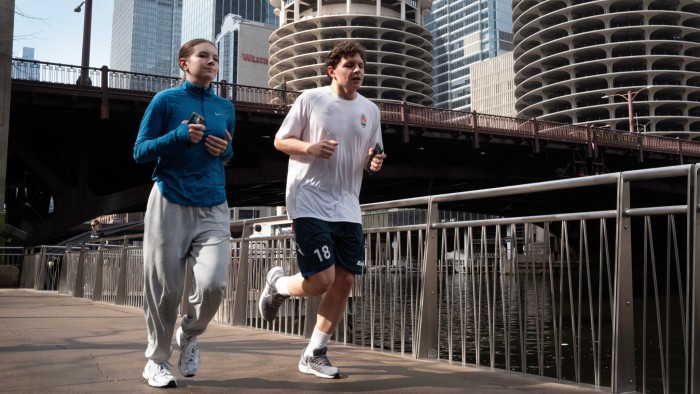Strava plans to launch an initial public offering in the US as the leading exercise-tracking app seeks to raise capital for more acquisitions amid a surge in the number of people taking up long distance running on both sides of the Atlantic.
Chief executive Michael Martin told the Financial Times that Strava has an “intention to go public at some point”, adding that there were a lot of benefits in doing so.
A listing “provides easy access to capital in case we wanted to do more and bigger acquisitions”, said the Strava chief, who declined to offer a precise timeline. Reuters reported last month that Strava had invited banks including Goldman Sachs and JPMorgan to pitch for roles on its IPO.
Strava, which launched in 2009, has grown rapidly since the pandemic, when it exploded in popularity by combining social networking with fitness. Users can record and share their workouts, give “kudos” to friends — similar to hitting Facebook’s “like” button — and compare their performance with both peers and elite athletes.
The exercise tracker had an average of 50mn monthly active users in 2025, close to double that of its closest rival, Garmin Connect, according to market intelligence group Sensor Tower. Downloads in the year to September were up around 80 per cent on the same period in 2024.
“Growth profiles like ours . . . are particularly uncommon, especially at scale,” Martin said. “It attracts a lot of attention — especially from bankers”.
The San Francisco-based company — whose investors include Sequoia Capital and Jackson Square Ventures — was last valued at $2.2bn in a funding round concluded in May, according to PitchBook.
Strava’s growth has coincided with a boom in running, particularly among Gen Z consumers, as people increasingly pursue healthier lifestyles.
More than 1.1mn people applied to run the 2026 London Marathon, a 31 per cent increase on last year, and the organisers of the New York City Marathon said in March that applications had grown by 22 per cent to more than 200,000.
Major sportswear brands — including Nike and Adidas — operate rival fitness-tracking apps. But Strava emerged as the “clear leader” in the growing market during the Covid pandemic thanks to its community focus and social networking features, according to Mintel retail analyst Bridget McCusker.
Martin, who previously ran Nike’s “connected fitness” apps, took over from Strava co-founder Michael Horvath in 2024. He said his main focus had been on adding tools to boost user growth and paid subscriptions, which make up the majority of the company’s revenues.
Sensor Tower estimates that, in the year to September, consumers spent more than $180mn on Strava Premium, which costs $11.99 a month or $79.99 per year. Strava declined to provide figures but said the amount was “far greater” than the estimate. The company also makes money through sponsored challenges and brand partnerships.
Strava has acquired rivals to add features to its app. This year it bought Runna, a UK-based coaching app, and cycling training platform The Breakaway — two purchases that “resolved a big weakness for Strava, which was its lack of personalised training plans”, said Mintel’s McCusker.
But while Strava has snapped up some upstart rivals it is locked in competition with athletics giant Garmin, the $50bn smartwatch and GPS-tracker company.
 A runner jogs past the Golden Gate bridge in San Francisco, where Strava was founded © Justin Sullivan/Getty Images
A runner jogs past the Golden Gate bridge in San Francisco, where Strava was founded © Justin Sullivan/Getty Images
Millions of amateur athletes use Strava and Garmin Connect, an app that links to the company’s smartwatches, simultaneously by sharing workouts recorded on their Garmin watches with their network on Strava. But that compatibility is now under threat.
Strava’s chief product officer Matt Salazar said on Reddit this month that Garmin had threatened to cut off access to its software from the beginning of next month unless Strava complies with new developer guidelines. These require it to display Garmin’s logo on activities recorded using its devices, which Salazar described as “blatant advertising”.
Strava, meanwhile, is suing Garmin for alleged patent infringement. Ultra-runner Andy Glaze shared details of the case on TikTok, asking his followers: “Have you seen the news that Mom and Dad are fighting?”
As Strava prepares for a potential IPO the spotlight will fall on how much room it still has to grow. While Martin insists the company still has a large pool of potential users to recruit from, some analysts believe Strava is now so mainstream that its scope for growth is limited.
McCusker said future growth will probably rely on “elevating its premium offering” to attract more subscribers and justify higher prices.
Still, many of those who have already signed up are hooked. Vassos Alexander, chair of south-west London running club Barnes Runners, said Strava has become “more than mainstream” in the fitness community.
Every Tuesday, when the running club’s members meet, dozens of athletes dutifully log their outing on the exercise-tracking app.
Strava, Alexander said, is “now almost as important to running as shoes”.

